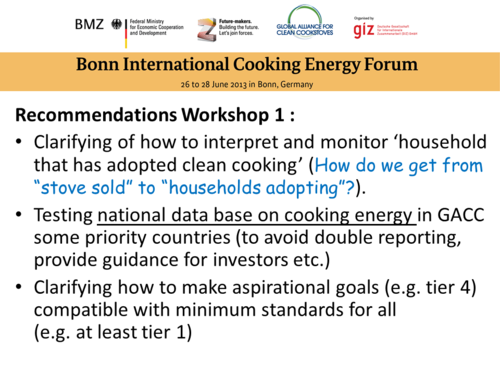Knowledge fuels change - Support energypedia!
For over 10 years, energypedia has been connecting energy experts around the world — helping them share knowledge, learn from each other, and accelerate the global energy transition.
Today, we ask for your support to keep this platform free and accessible to all.
Even a small contribution makes a big difference! If just 10–20% of our 60,000+ monthly visitors donated the equivalent of a cup of coffee — €5 — Energypedia would be fully funded for a whole year.
Is the knowledge you’ve gained through Energypedia this year worth €5 or more?
Your donation keeps the platform running, helps us create new knowledge products, and contributes directly to achieving SDG 7.
Thank you for your support, your donation, big or small, truly matters!
Difference between revisions of "How Can We Contribute to Measure the "100 Million by 2020" Goal? - Workshop 1 Recommendations Bonn 2013"
***** (***** | *****) m |
***** (***** | *****) |
||
| Line 5: | Line 5: | ||
| <br/> | | <br/> | ||
|} | |} | ||
| + | |||
= <span style="font-size: 22.22222328186035px; line-height: 31.111112594604492px;">Workshop 1: How Can We Contribute to Measure the "100 Million by 2020" Goal?</span> = | = <span style="font-size: 22.22222328186035px; line-height: 31.111112594604492px;">Workshop 1: How Can We Contribute to Measure the "100 Million by 2020" Goal?</span> = | ||
| Line 13: | Line 14: | ||
<br/> | <br/> | ||
| − | [[File:BICEF Recommendations Workshop 1.png|center|500px|alt=BICEF Recommendations Workshop 1.png]] | + | [[File:BICEF Recommendations Workshop 1.png|center|500px|alt=BICEF Recommendations Workshop 1.png]]This workshop focused on the achievements to date and the contributions to the Global Alliances's overarching goal of 100 million homes adopting clean and efficient stoves and fuels by 2020. Furthermore, monitoring approaches of different cooking energy interventions at global, international and national level will be presented, and options for harmonising monitoring interests and methods were discussed. Participants also analysed and discussed the current supply of and demand for information for reporting on the objective of '100 million by 2020' and elaborate on possible achievemnts. |
| + | |||
= Key Areas Discussed = | = Key Areas Discussed = | ||
Revision as of 22:15, 28 June 2013
| ► Back to Forum Overview |
Workshop 1: How Can We Contribute to Measure the "100 Million by 2020" Goal?
- Facilitator/Chair: Dr. Christoph Messinger, GIZ/EnDev
- Rapporteur: Dr. Anne Wheldon, Ashden
This workshop focused on the achievements to date and the contributions to the Global Alliances's overarching goal of 100 million homes adopting clean and efficient stoves and fuels by 2020. Furthermore, monitoring approaches of different cooking energy interventions at global, international and national level will be presented, and options for harmonising monitoring interests and methods were discussed. Participants also analysed and discussed the current supply of and demand for information for reporting on the objective of '100 million by 2020' and elaborate on possible achievemnts.
Key Areas Discussed
1. We discussed the interpretation of the GACC aspirational goal of 100 million households, and SE4All goal of universal energy access, including whether the two goals are compatible, and how they link to national targets and plans.
2. We looked at the detail of data to be collected and some of the difficulties in this, in particular how to go from stoves sold -> households with access to clean cooking -> households adopting clean cooking.
3. We heard the experiences of three GACC members (EnDev, WLPGA, Government of Kenya) with monitoring their work, and discussed challenges, good examples and different ways in which monitoring could be harmonized to meet GACC needs.
Recommendations
1. Establishment of national data bases on cooking energy. These would be useful to avoid double counting of stoves, for investors and stove programmes, and also for other government activities as well as stoves. However, there is no general recommendation about what organisation should host such a data base or who is responsible for data collection.
2. A generally accepted interpretation is needed of the meaning of ‘household that has adopted clean cooking’, along with guidance on how this should be monitored.
3. As far as possible, the existing monitoring structures of stakeholders in the stove sector should be used for GACC reporting.
Specific Action Proposed (Including Responsibilities)
1. National cooking data bases should be piloted in some of the priority countries of GACC or World Bank/ESMAP
2. The GACC secretariat and members should work jointly to agree the interpretation of ‘household that has adopted clean cooking’, and to produce guidance on monitoring.
3. The GACC secretariat and members should work jointly to review existing monitoring structures, and develop a document or toolkit that identifies gaps in current reporting and explains what is needed to make reporting comprehensive.




















